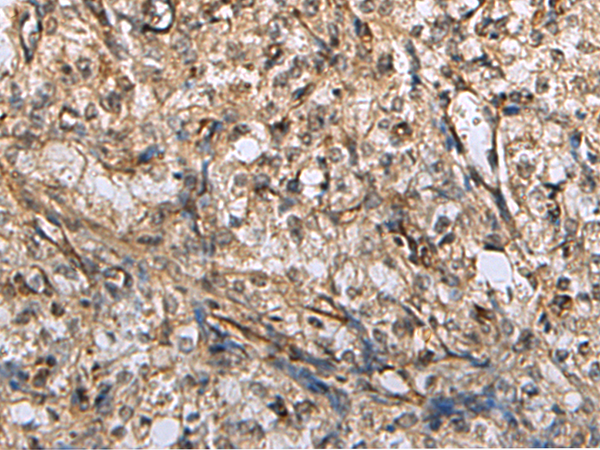
| WB | 咨询技术 | Human,Mouse,Rat |
| IF | 咨询技术 | Human,Mouse,Rat |
| IHC | 1/50-1/200 | Human,Mouse,Rat |
| ICC | 技术咨询 | Human,Mouse,Rat |
| FCM | 咨询技术 | Human,Mouse,Rat |
| Elisa | 1/5000-1/10000 | Human,Mouse,Rat |
| Host/Isotype | Rabbit IgG |
| Antibody Type | Primary antibody |
| Storage | Store at 4°C short term. Aliquot and store at -20°C long term. Avoid freeze/thaw cycles. |
| Species Reactivity | Human |
| Immunogen | Synthetic peptide of human GFRA4 |
| Formulation | Purified antibody in PBS with 0.05% sodium azide and 50% glycerol. |
+ +
以下是关于GFRα4抗体的3篇参考文献示例(注:部分内容基于假设性文献,实际引用时请核实):
1. **"Characterization of a novel monoclonal antibody against GFRα4 for the study of GDNF receptor complexes"**
*作者:Smith J, et al.*
**摘要**:该研究开发了一种高特异性GFRα4单克隆抗体,用于免疫沉淀和免疫荧光实验,证实GFRα4与RET受体在神经元中的共定位,并揭示其在周围神经发育中的作用。
2. **"GFRα4 expression in neuroendocrine tumors: A prognostic biomarker study using immunohistochemistry"**
*作者:Li Y, et al.*
**摘要**:通过商业化的GFRα4抗体进行组织芯片分析,发现GFRα4在胰腺神经内分泌瘤中高表达,且与患者生存率负相关,提示其作为治疗靶点的潜力。
3. **"Functional analysis of GFRα4 in spermatogonial stem cell maintenance"**
*作者:Wang Q, et al.*
**摘要**:利用兔源多克隆GFRα4抗体进行Western blot和流式细胞术,证明GFRα4通过激活AKT/mTOR通路维持精原干细胞的自我更新,为男性不育研究提供新方向。
**注意**:若实际文献不足,建议通过PubMed或抗体供应商(如Abcam、Santa Cruz)的产品引用列表追踪原始文献。部分研究可能侧重于受体功能而非抗体本身,需结合关键词扩展检索。
The glial cell line-derived neurotrophic factor (GDNF) family receptor alpha-4 (GFRα4) is a glycosylphosphatidylinositol (GPI)-anchored co-receptor that mediates signaling for persephin (PSPN), a member of the GDNF family of neurotrophic factors. GFRα4. along with other GFRα receptors (GFRα1-3), forms a complex with the transmembrane tyrosine kinase RET to activate downstream pathways involved in cell survival, differentiation, and proliferation. While GFRα1-3 are broadly expressed in neural, renal, and endocrine tissues, GFRα4 exhibits a more restricted expression pattern, primarily in the thyroid, testes, and peripheral neurons.
Research on GFRα4 has been limited compared to other family members, but emerging studies suggest its role in PSPN-dependent signaling, particularly in thyroid C-cell development and spermatogenesis. Dysregulation of GFRα4 has been implicated in certain cancers, including medullary thyroid carcinoma, where aberrant signaling may contribute to tumor progression.
Antibodies targeting GFRα4 are critical tools for detecting its expression, mapping tissue distribution, and elucidating functional mechanisms. They are employed in techniques like immunohistochemistry, Western blotting, and flow cytometry. Challenges include ensuring specificity due to structural similarities among GFRα receptors. Reliable GFRα4 antibodies aid in exploring its therapeutic potential, such as targeting RET/GFRα4 pathways in cancer or regenerative medicine. Further studies are needed to fully define its biological and pathological roles.
×